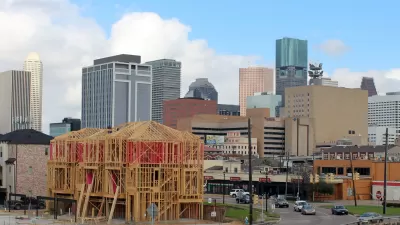Zoning can only be so effective in holding off market forces, according to this column. New York City seems to have finally learned this lesson in the Garment District, but will it inform decisions in other parts of the city?

Crain's New York Business columnist Greg David writes that New York City has fixed its "worst land-use mistake."
The decision in question dates to 1984, when political forces concerned about the potential for rising rents to drive businesses away resulted in manufacturing only zoning for side streets n the Garment District. "Apparel jobs vanished anyway—some 12,000 remain in the city and fewer than 5,000 in the Garment Center—in a telling example of how land-use policy is helpless in the face of economic forces," according to David.
"After almost two decades of trying, the city will finally end the restrictive zoning this fall," reports David.
According to David, the zoning changes reflect a city, and a planning regime, that has faced reality when it comes to manufacturing jobs, and the amount of space reserved for manufacturing uses around the city.
"In recent years, architects and design firms have swept in, along with tech companies and nonprofits—some in space restricted to manufacturers—bringing in a new, affluent workforce," writes David. "Even more transformational, the district is now home to 42 hotels, with 12 more under construction. Tourists have in turn lured restaurants and bars."
FULL STORY: Finally, a fix for the city's worst land-use mistake

Alabama: Trump Terminates Settlements for Black Communities Harmed By Raw Sewage
Trump deemed the landmark civil rights agreement “illegal DEI and environmental justice policy.”

Planetizen Federal Action Tracker
A weekly monitor of how Trump’s orders and actions are impacting planners and planning in America.

The 120 Year Old Tiny Home Villages That Sheltered San Francisco’s Earthquake Refugees
More than a century ago, San Francisco mobilized to house thousands of residents displaced by the 1906 earthquake. Could their strategy offer a model for the present?

In Both Crashes and Crime, Public Transportation is Far Safer than Driving
Contrary to popular assumptions, public transportation has far lower crash and crime rates than automobile travel. For safer communities, improve and encourage transit travel.

Report: Zoning Reforms Should Complement Nashville’s Ambitious Transit Plan
Without reform, restrictive zoning codes will limit the impact of the city’s planned transit expansion and could exclude some of the residents who depend on transit the most.

Judge Orders Release of Frozen IRA, IIJA Funding
The decision is a victory for environmental groups who charged that freezing funds for critical infrastructure and disaster response programs caused “real and irreparable harm” to communities.
Urban Design for Planners 1: Software Tools
This six-course series explores essential urban design concepts using open source software and equips planners with the tools they need to participate fully in the urban design process.
Planning for Universal Design
Learn the tools for implementing Universal Design in planning regulations.
Clanton & Associates, Inc.
Jessamine County Fiscal Court
Institute for Housing and Urban Development Studies (IHS)
City of Grandview
Harvard GSD Executive Education
Toledo-Lucas County Plan Commissions
Salt Lake City
NYU Wagner Graduate School of Public Service





























